5 Key Factors Influencing Cannabis Nutrient Availability
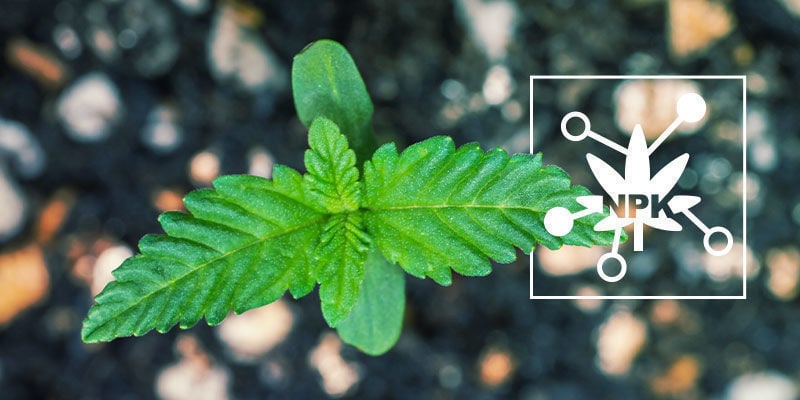
How important do you consider fertilisation when growing cannabis? For most growers, the answer is probably "very important". But fertilisation only plays one part in the amount of nutrients your plants can absorb from the soil. In this article, we take an in-depth look at 5 factors that have a huge impact on nutrient availability for cannabis.
Beginner cannabis growers often fall into the trap of focusing their efforts in the garden chiefly on fertilising. But there's much more to feeding your plants than giving them fertiliser. In this article, we'll shine a light on five of the most important factors affecting nutrient availability and uptake in cannabis plants. Keep reading to learn what they are.
1. Temperature
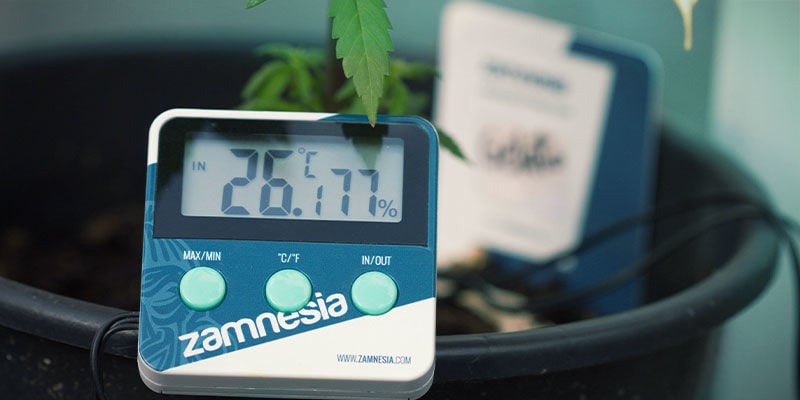
The temperature in your grow room, tent, or garden has a huge impact on the health of your weed plants. Generally speaking, cannabis prefers daytime temperatures of roughly 20–30°C and nighttime temperatures of 17–20°C. When the temperature falls below or climbs above this range, many of the biological processes that keep plants alive and growing start to suffer. Specifically, unfavourable temperatures in your grow room/garden affect the microbial and mycorrhizal activity in your growing medium, the temperature of the water (which in turn impacts other plant processes), and enzyme activity inside the plant's organism.
How temperature affects microbial and mycorrhizal activity
In low temperatures, the microbial/mycorrhizal cycling of nitrogen and phosphorus drops significantly. This is very important, because microbial nitrogen cycling is responsible for over 50% of nitrogen uptake in plants, and mycorrhizal fungi are also greatly responsible for a plant's uptake of nutrients (particularly phosphorus) and water. Microbial nitrogen production, for example, is at its highest between 24–35°C.
Mycorrhizal activity is also thought to drop notably at temperatures below 15°C (Gavito et al., 2005). Both microbial and mycorrhizal fungi activity also drop as temperatures rise above roughly 35°C. Without the help of these bacteria and fungi, plants exposed to unfavourable temperatures won't be able to uptake nutrients or water, no matter how much fertiliser you pour into/on top of their soil every week.
How temperature affects water, photosynthesis, respiration, and more
The temperature in your grow room or garden directly affects the temperature of the water in a plant's medium and organism. This, in turn, directly affects the rate at which your plants photosynthesise, respire, and transpire. Higher temperatures increase the rate at which plants transpire and uptake both water and nutrients. Colder temperatures, on the other hand, slow down transpiration and nutrient/water uptake. Extremely low temperatures can also affect nutrient transport (nutrient ions are transported in water). Stomata, a key player in photosynthesis, are also less productive in colder temperatures.
How temperature affects enzymatic activity
Enzymes facilitate chemical activity in plants, and therefore greatly impact their health and growth. And like with microbes, fungi, and water, enzyme activity is highly dependent on temperature. When we track and graph enzyme activity at different temperatures, we get a bell curve. As temperature increases, so does the activity of enzymes, because both the enzymes and their substrates (i.e. the molecules they react with) are able to move, and thereby interact, at a faster rate. Beyond certain temperatures, however, enzyme activity rapidly decreases back to zero.
2. pH level

There's a very good reason experienced cannabis growers are constantly measuring pH (aka “potential hydrogen”, which is simply a measure of the amount of hydrogen ions in soil or other solutions). Generally speaking, cannabis likes slightly acidic soil with a pH of 6.0–7.0. In hydro or soilless setups, the ideal pH changes to around 5.5–6.5. Proper pH is important for a number of reasons, but it has particularly notable effects on nutrient availability, and therefore cannabis’ ability to feed.
The importance of pH for nutrient uptake
pH imbalances are one of the most common causes of nutrient deficiencies, nutrient lockout, and nutrient burn in cannabis. When soil pH falls below the optimal range mentioned above, microbial activity in the soil changes and most nutrients (notably calcium, magnesium, and phosphorus) become unavailable to plants. Meanwhile, aluminium and manganese become more available in acidic soils, and can prove toxic. If soil pH rises above 6.5–7.0, phosphorus and most micronutrients become unavailable to the plant.
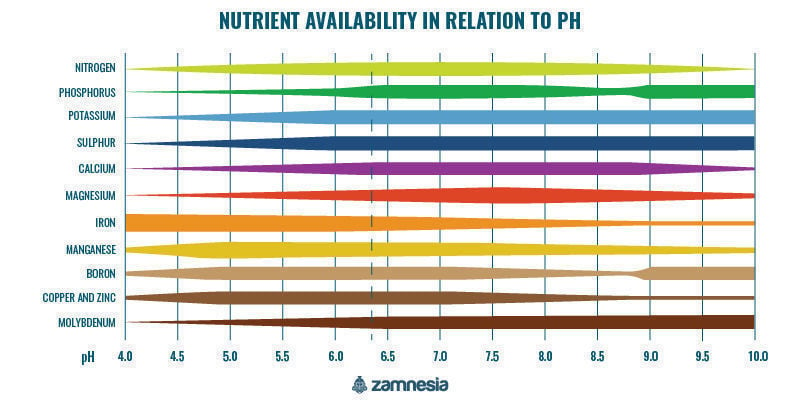
A note on organic and non-organic gardening
Organic cannabis cultivation is becoming ever more popular because, while it might sound complicated, it can actually facilitate many of the more complex aspects of growing, such as pH regulation. Feeding cannabis with bottled nutrients might seem simple, but it can be challenging to get right, especially for beginner growers.
Using an organic medium from the outset, and enriching it with natural fertilisers such as compost, worm castings, manure, and bone/fish meals, naturally creates an environment rich in beneficial bacteria and fungi like mycorrhizae. In the presence of these microorganisms, your plants will feed more gradually and stay protected against many common pests and pathogens.
The importance of soil and water testing
Regularly checking and tracking pH is key for catching any potential pH imbalances early. Obviously, measuring the pH of your soil is very important, but you must also be sure to measure (and amend, if needed) the pH of your water. When it enters the soil, water can dissolve minerals within it, converting them into ions available to the plant. At the same time, water can also remove mineral ions from the soil by literally flushing them out. Both outcomes can directly affect the pH of your medium, and the amount of nutrients available to your plants.
To avoid pH imbalances, we recommend monitoring your soil pH regularly throughout your grow. Meanwhile, you can usually get away with testing the pH of your water right at the start of your grow, as it likely won't change much over the duration. However, be sure to test the pH of your nutrient solution before feeding your plants. It’s also worth checking the pH of the runoff that comes out of the bottom of your growing containers, as this will give you a good idea of what’s going on in the substrate.
The value of good compost
While the use of chemical fertilisers has long been the norm among cannabis growers, organic practices are rising in popularity. One simple way of incorporating organics into your grow is to buy or make your own compost. Compost naturally has a pH of roughly 6.5–7.0, which is ideal for cannabis and most other plants. Plus, soil prepared with organic fertilisers like compost can actually hold and absorb hydrogen ions without affecting overall pH—a process known as "buffering" among gardeners. Organic soils also naturally have more nutrient cations that can store plant-available nutrients, ready for when plants need them.
3. Soil aeration
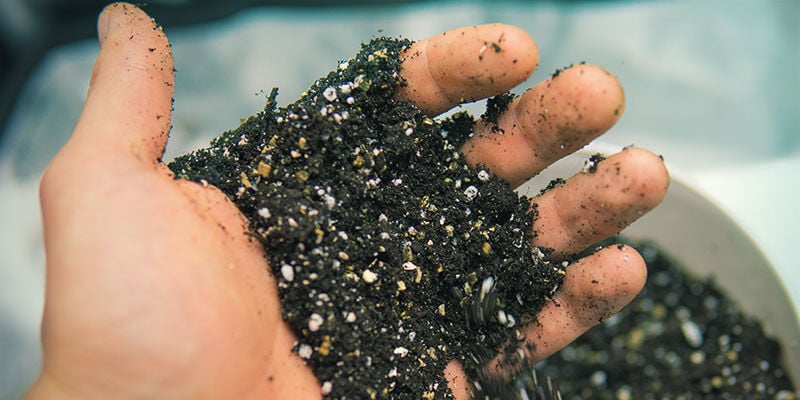
The aeration of your soil directly impacts what nutrients are available to your plants. Cannabis, like many other plants, grows best in well-aerated soil, and there are a couple of reasons for this. Namely, it promotes healthy air and water exchange, and allows beneficial microbial and mycorrhizal activity to thrive.
Aerated soil promotes healthy air and water exchange
Aerated soils promote the natural exchange of water and air around the root zone. In order to grow healthy roots (the foundation of a healthy plant), cannabis plants need to take up atmospheric oxygen via their root systems. At the same time, they also release CO₂ into the soil, which needs to evaporate into the atmosphere. This interchange of gases happens naturally, and at high level, in well-aerated soils. In poorly aerated soils, however, roots cannot uptake as much oxygen from the atmosphere, and will stop growing, which jeopardises the entire health of the plant. Similarly, CO₂ cannot freely leach from the soil into the atmosphere in poorly aerated soils, and can instead build up in the soil. Finally, the ability of your plants to uptake water (and in turn nutrients) is also severely restricted in compact, poorly aerated soils.
Better for microbial and mycorrhizal activity
The higher levels of oxygen naturally present in well-aerated soils also benefit microbial and mycorrhizal activity. Like most living things, the beneficial microbes and fungi mentioned earlier need oxygen in order to live and reproduce. In 2022, a group of researchers from China published the results of a 3-year field experiment conducted in bamboo plantations. The researchers tested the effects of aerating soil in the plantation, and found that it not only greatly increased oxygen levels, but also nutrient availability, which in turn increased the activity of both bacteria and enzymes involved in the uptake of nutrients—particularly nitrogen and potassium (Qian et al., 2022).
4. Mineral and organic composition of soil
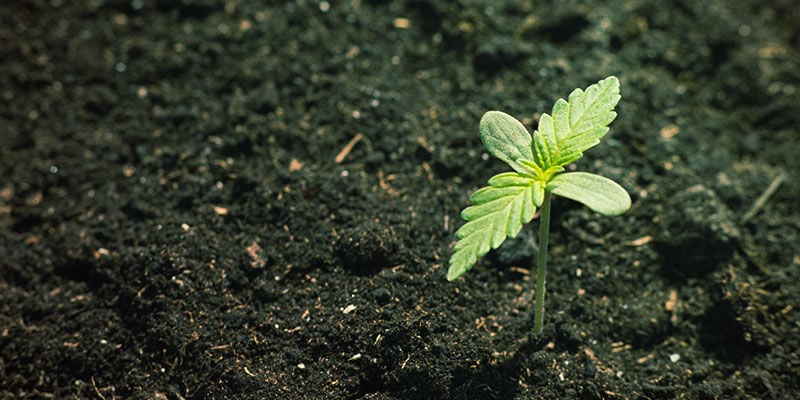
Another major factor impacting cannabis nutrient availability is soil composition. Soils with greater electronegativity and surface area have a higher cation exchange capacity (CEC), and well-tilled and aerated soil has greater surface area than compact, compressed soil. To understand what that means, it helps to think back to your school chemistry class where you learned about the electric charge of atoms. Most soils tend to have a negative charge, while most nutrients have a positive one. This allows nutrient particles to cling to minerals that make up soil, such as clay and organic matter, and thereby avoid being leached out of the soil when it rains, for example.
In order for a plant to absorb nutrients from soil, a cation exchange must take place; that is, a chemical reaction in which particles within a plant are exchanged for particles in the soil (say, the exchange of one hydrogen ion for one potassium ion). Soils with a higher CEC need to be fertilised less often but in higher doses, while soils with a low CEC benefit from lighter yet more frequent fertilisation to maximise nutrient availability to plants.
5. Soil moisture
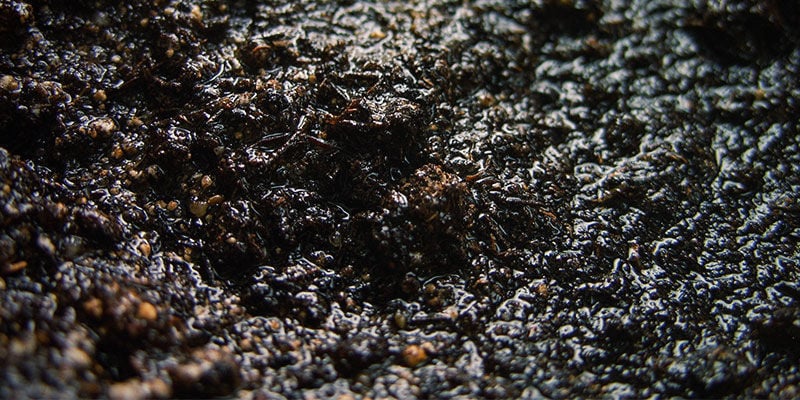
Last, but not least, one of the biggest factors affecting the availability of nutrients in your soil is moisture. The amount of water in your soil can both increase and reduce nutrient capacity by impacting pH, mass flow, and root pressure. In the right amount, water can release nutrients into the soil by triggering chemical reactions and weathering down soil components. Too much water, however, can leach nutrients from the soil—specifically nitrate and phosphorus, which are negatively charged and therefore cannot cling to soil with an electronegative charge. At the same time, without the right amount of water, bacteria in the soil won't produce usable nitrogen, which can in turn also impact mycorrhizal activity in the soil.
The complex nature of nutrient availability in cannabis
As you can see from this article, there's a lot more to plant nutrition than simply fertilisation. While we couldn't explore these topics in full detail in the scope of this post, we hope it shines a light on the myriad factors that can influence nutrient availability, and why it’s so important to dial in each of the above factors to the best of your ability.














 United States
United States










